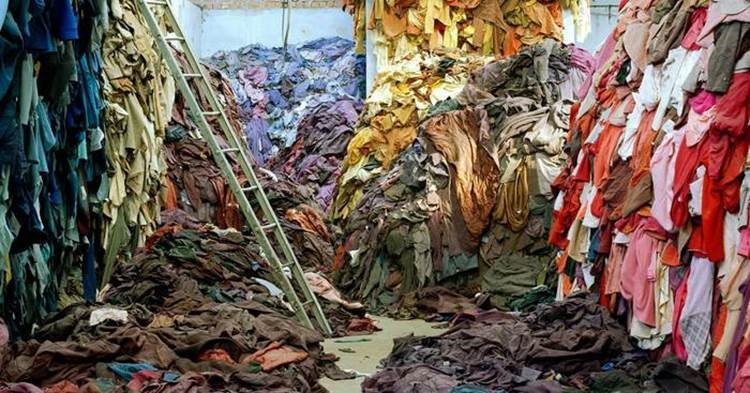The Impact of Fast Fashion On the Environment
Contributor: Ngan Le
Introduction
As an individual strolls into a store and purchases a few items at the mall, a thought that may cross our mind is how it is possible for such affordable clothing to be made in mass quantities. Of course, the fast fashion industry and its respective factories found a way. Among the various issues regarding fast fashion and how its industry has been able to boom, the various destructive effects on the environment remain a major concern. To manufacture clothes, the fast fashion industry exports its production business overseas for cheap labor to avoid the high minimum wages implemented by many developed governments. Even though typical consumers in the North American market may be able to afford clothes for a cheaper price, fast fashion comes with a price tag with a handful of consequences. Thus, it falls upon us - the consumers - to explore alternatives to tackle the neglected environmental impact of such consumerism.
Excessive Usage of Water
The fashion industry consumes one tenth of all of the water used industrially to run factories and clean products. To put this into perspective, it takes 10,000 liters of water to produce one kilogram of cotton or approximately 3,000 liters of water for one cotton shirt. Furthermore, textile dyeing requires toxic chemicals that subsequently end up in our oceans. Approximately 20% of the wastewater worldwide is attributed to this process, which accumulates over time. As many factories moved overseas as stated previously, they may be in countries without strict environmental regulations, resulting in untreated water to enter the oceans. Regrettably, the wastewater created is extremely toxic and in many cases, cannot be treated to become safe again.
Image of dyes dumped in ocean waters by fast fashion factories from Greenpeace.
Plastic Microfibers
Next, synthetic materials are the primary culprits that cause plastic microfibers to enter our oceans. To be exact, approximately 35% of all microplastics are from these synthetic materials. To further lower the price, producers turn to materials that may be of low quality. For example, many of the fibers are made of polyester, consisting of plastic and tend to release far more carbon emissions than cotton. Furthermore, plastic is slow to degrade in the ocean until a long time has passed. When plastic finally breaks down, it creates a toxic substance with a harmful impact on the marine ecosystems. As these plastic microfibers cannot be removed, they end up in the human food chain through aquatic life, causing many negative health effects. There are a variety of ways they can enter our ocean - most commonly from our usage of the washing machine. Though it is evident that the washing machine has been an essential appliance in our households, it’s important to wash full-loads when possible to minimize excess consumption of water.
Excessive Consumption of Clothing
Due to how affordable the clothing is and how new trends convince consumers to seek out more, the value of clothes may diminish in the eyes of consumers. As of 2019, the current report shows that 62 million metric tons of apparel were consumed globally. Over time, the amount that our society has consumed has skyrocketed in recent decades. Although it may be beneficial to our economy, more items tend to end up at the landfills because the lower quality clothes are worn out only after a few washes and this demands for more new clothes. Amongst a variety of issues present, the two main concerns involve piles of clothing in landfills and incinerated clothing. Whether it is simply growing out of the clothes or that the clothes are no longer in style, a significant proportion of the population opts to throw away their clothes instead of donating them. Additionally, due to the number of cut outs for the clothing, a large amount of materials are being wasted as they cannot be used any further for one certain type of production. 57% of all discarded clothing ends up in landfill; the landfills start to pile up, then the trash is moved to an area to be incinerated. This process poses multiple public health and environmental dangers to the people who live in nearby communities as toxic substances or large amounts of poisonous gases are released as a result of burning landfill. Despite new technology creating filters to capture the pollutants, they remain present and often are turned into a dangerous substance, which later returns back to the landfills and pollutes our air.
Image of a landfill with mountains of clothes due to fast fashion from the University of Queensland.
Usage of Viscose
From the beginning of cellulosics, viscose was introduced in 1890 as a cheaper alternative to cotton for production. Viscose, also known as rayon, is a common cellulosic fiber made from wood pulp. It has extremely detrimental effects on the environment such as the usage of harmful chemicals and the unethical resourcing for the material. As the companies use toxic chemicals, others are worried about other impacts beyond environmental factors For instance, the carbon disulphide that is used in viscose fiber production leads to lethal health side effects on workers as well. Thus, perhaps it is not surprising that viscose consequently results in a larger amount of greenhouse gas emissions than cotton production.
An Alternative to Viscose
Instead of using viscose, there are alternatives that we can opt for such as more sustainable cellulosic fibers. In Finland, a company named Spinnova has transformed wood fibers into recyclable fibers without harmful chemicals such as caustic soda, carbon disulphide, and sodium hydroxide that are commonly found in viscose. Inspired from the web-weaving by spiders, the method is applied with wood fiber material. It reportedly uses 99% less water than cotton production. The method is particularly promising because it is far safer, uses less resources, and provides support that sourcing sustainably is not impossible for many other companies. With a growing concern among the general population, many start-ups have taken on the challenge of sourcing cellulosics from a myriad of other sources such as orange, milk and coffee. For instance, modal from the 1950s and lyocell from the 1970s are both revolutionary by being biodegradable, using less fiber, less dye and better for moisture absorption or moisture-wicking than many other fibers. As a result, they have grown in popularity with consumers and a vast amount of companies nowadays. Though the issue of sustainability is evident, there have been a variety of innovations over time that are moving the industry in the right direction. As the movement gains momentum, we have the ability to make a significant change. By supporting companies such as Spinnova, we actively are building towards a cleaner and greener future, one step at a time.
The process of how Spinnova sources their sustainable cellulosic fibers from Spinnova.
Conclusion
The fashion industry is currently responsible for more annual carbon emissions than all international flights and maritime shipping combined. If the industry maintains its course, an increase of 50% in greenhouse gas emissions is expected within a decade. By analyzing the root causes of the problem, the next steps are easier to understand as we can connect the dots and create solutions. A few possible solutions were listed in the article, but some others include mindful purchasing of fast fashion brands and supporting reform. If you are not entirely sure of which brands to support, you are not alone. Doing background research on brands before purchasing clothes can help you become a more informed consumer and steer your purchases in a manner that aligns with your environmental values. The fashion industry has caused a substantial amount of damage to our environment. However, if we start to take proactive steps towards advocating for a green-friendly fashion industry and becoming an environmentally-conscious consumer, we can finally slow down climate change.



